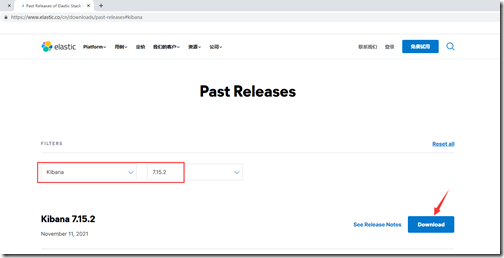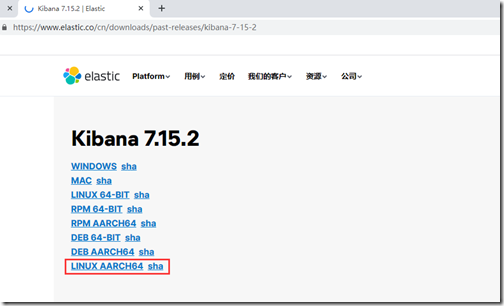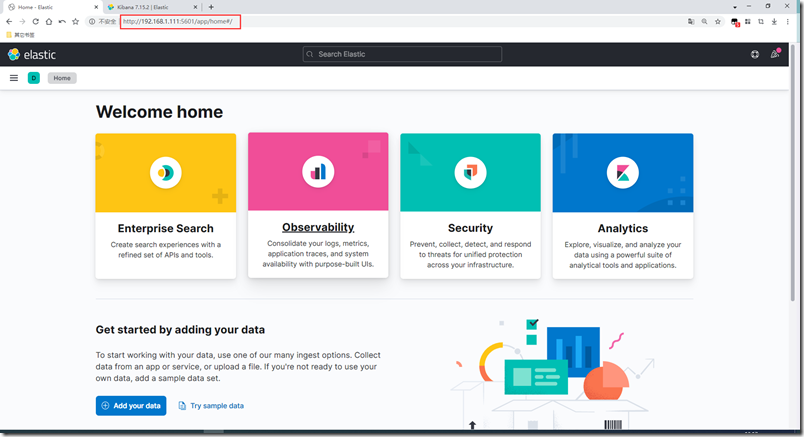前言
操作系统:Kylin Linux Advanced Server release V10 (Tercel)
Kibana-7.15.2
一、下载地址
https://artifacts.elastic.co/downloads/kibana/kibana-7.15.2-linux-aarch64.tar.gz
二、安装
下载压缩包并解压之后,需要关注两个文件夹,一个是config文件夹,里面的kibana.yml是配置文件;一个是bin文件夹,里面有kibana启动的bat脚本
上传kibana-7.15.2-linux-aarch64.tar.gz文件到 /opt目录下,并解压
tar -zxvf kibana-7.15.2-linux-aarch64.tar.gz在目录/usr/local下创建目录:kibana-7.15.2
mkdir kibana-7.15.2复制解压后的文件到/usr/local/kibana-7.15.2目录下
cp -R /opt/kibana-7.15.2-linux-aarch64/* /usr/local/kibana-7.15.2/设置 kibana-7.15.2 目录权限给elasticsearch用户
chown -R elasticsearch:elasticsearch kibana-7.15.2/三、设置配置文件
修改/usr/local/kibana-7.6.0/config/kibana.yml
设置ElasticSearch的访问地址:
elasticsearch.hosts: [http://192.168.1.111:9200]设置Kibana的访问地址,如果不设置则只能本机访问。
server.host: "192.168.1.111" 或者 server.host: "0.0.0.0"- # Kibana is served by a back end server. This setting specifies the port to use.
- #server.port: 5601
-
- # Specifies the address to which the Kibana server will bind. IP addresses and host names are both valid values.
- # The default is 'localhost', which usually means remote machines will not be able to connect.
- # To allow connections from remote users, set this parameter to a non-loopback address.
- server.host: "0.0.0.0"
-
- # Enables you to specify a path to mount Kibana at if you are running behind a proxy.
- # Use the `server.rewriteBasePath` setting to tell Kibana if it should remove the basePath
- # from requests it receives, and to prevent a deprecation warning at startup.
- # This setting cannot end in a slash.
- #server.basePath: ""
-
- # Specifies whether Kibana should rewrite requests that are prefixed with
- # `server.basePath` or require that they are rewritten by your reverse proxy.
- # This setting was effectively always `false` before Kibana 6.3 and will
- # default to `true` starting in Kibana 7.0.
- #server.rewriteBasePath: false
-
- # Specifies the public URL at which Kibana is available for end users. If
- # `server.basePath` is configured this URL should end with the same basePath.
- #server.publicBaseUrl: ""
-
- # The maximum payload size in bytes for incoming server requests.
- #server.maxPayload: 1048576
-
- # The Kibana server's name. This is used for display purposes.
- #server.name: "your-hostname"
-
- # The URLs of the Elasticsearch instances to use for all your queries.
- elasticsearch.hosts: ["http://localhost:9200"]
-
- # Kibana uses an index in Elasticsearch to store saved searches, visualizations and
- # dashboards. Kibana creates a new index if the index doesn't already exist.
- #kibana.index: ".kibana"
-
- # The default application to load.
- #kibana.defaultAppId: "home"
-
- # If your Elasticsearch is protected with basic authentication, these settings provide
- # the username and password that the Kibana server uses to perform maintenance on the Kibana
- # index at startup. Your Kibana users still need to authenticate with Elasticsearch, which
- # is proxied through the Kibana server.
- #elasticsearch.username: "kibana_system"
- #elasticsearch.password: "pass"
-
- # Kibana can also authenticate to Elasticsearch via "service account tokens".
- # If may use this token instead of a username/password.
- # elasticsearch.serviceAccountToken: "my_token"
-
- # Enables SSL and paths to the PEM-format SSL certificate and SSL key files, respectively.
- # These settings enable SSL for outgoing requests from the Kibana server to the browser.
- #server.ssl.enabled: false
- #server.ssl.certificate: /path/to/your/server.crt
- #server.ssl.key: /path/to/your/server.key
-
- # Optional settings that provide the paths to the PEM-format SSL certificate and key files.
- # These files are used to verify the identity of Kibana to Elasticsearch and are required when
- # xpack.security.http.ssl.client_authentication in Elasticsearch is set to required.
- #elasticsearch.ssl.certificate: /path/to/your/client.crt
- #elasticsearch.ssl.key: /path/to/your/client.key
-
- # Optional setting that enables you to specify a path to the PEM file for the certificate
- # authority for your Elasticsearch instance.
- #elasticsearch.ssl.certificateAuthorities: [ "/path/to/your/CA.pem" ]
-
- # To disregard the validity of SSL certificates, change this setting's value to 'none'.
- #elasticsearch.ssl.verificationMode: full
-
- # Time in milliseconds to wait for Elasticsearch to respond to pings. Defaults to the value of
- # the elasticsearch.requestTimeout setting.
- #elasticsearch.pingTimeout: 1500
-
- # Time in milliseconds to wait for responses from the back end or Elasticsearch. This value
- # must be a positive integer.
- #elasticsearch.requestTimeout: 30000
-
- # List of Kibana client-side headers to send to Elasticsearch. To send *no* client-side
- # headers, set this value to [] (an empty list).
- #elasticsearch.requestHeadersWhitelist: [ authorization ]
-
- # Header names and values that are sent to Elasticsearch. Any custom headers cannot be overwritten
- # by client-side headers, regardless of the elasticsearch.requestHeadersWhitelist configuration.
- #elasticsearch.customHeaders: {}
-
- # Time in milliseconds for Elasticsearch to wait for responses from shards. Set to 0 to disable.
- #elasticsearch.shardTimeout: 30000
-
- # Logs queries sent to Elasticsearch. Requires logging.verbose set to true.
- #elasticsearch.logQueries: false
-
- # Specifies the path where Kibana creates the process ID file.
- #pid.file: /run/kibana/kibana.pid
-
- # Enables you to specify a file where Kibana stores log output.
- #logging.dest: stdout
-
- # Set the value of this setting to true to suppress all logging output.
- #logging.silent: false
-
- # Set the value of this setting to true to suppress all logging output other than error messages.
- #logging.quiet: false
-
- # Set the value of this setting to true to log all events, including system usage information
- # and all requests.
- #logging.verbose: false
-
- # Set the interval in milliseconds to sample system and process performance
- # metrics. Minimum is 100ms. Defaults to 5000.
- #ops.interval: 5000
-
- # Specifies locale to be used for all localizable strings, dates and number formats.
- # Supported languages are the following: English - en , by default , Chinese - zh-CN .
- #i18n.locale: "en"
四、启动
如果用root用户启动会报错:
Kibana should not be run as root. Use --allow-root to continue.切换elasticsearch用户,并进入目录:/usr/local/kibana-7.15.2/bin 启动服务
./kibana五、测试访问
http://192.168.1.111:5601/app/home#/
六、开机启动
建立服务文件
vi /lib/systemd/system/kibana.service- [Unit]
- Description=Kibana
- [Service]
- LimitNOFILE=100000
- LimitNPROC=100000
- ExecStart=/usr/local/kibana-7.15.2/bin/kibana
- User=elasticsearch
- Group=elasticsearch
- [Install]
- WantedBy=multi-user.target
设置开机自启动
重新加载systemd的守护线程:- systemctl daemon-reload
-
- systemctl enable kibana
其它
- 启动elasticsearch.service:
- systemctl start kibana.service
-
- 查看kibana.serivce状态:
- systemctl status kibana.service
ps aux|grep kibana如果出现错误可以使用如下命令查看日志:journalctl -u kibana.service


